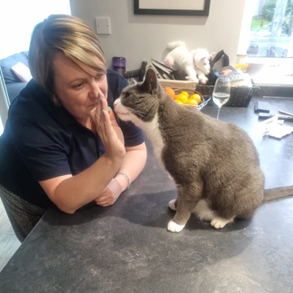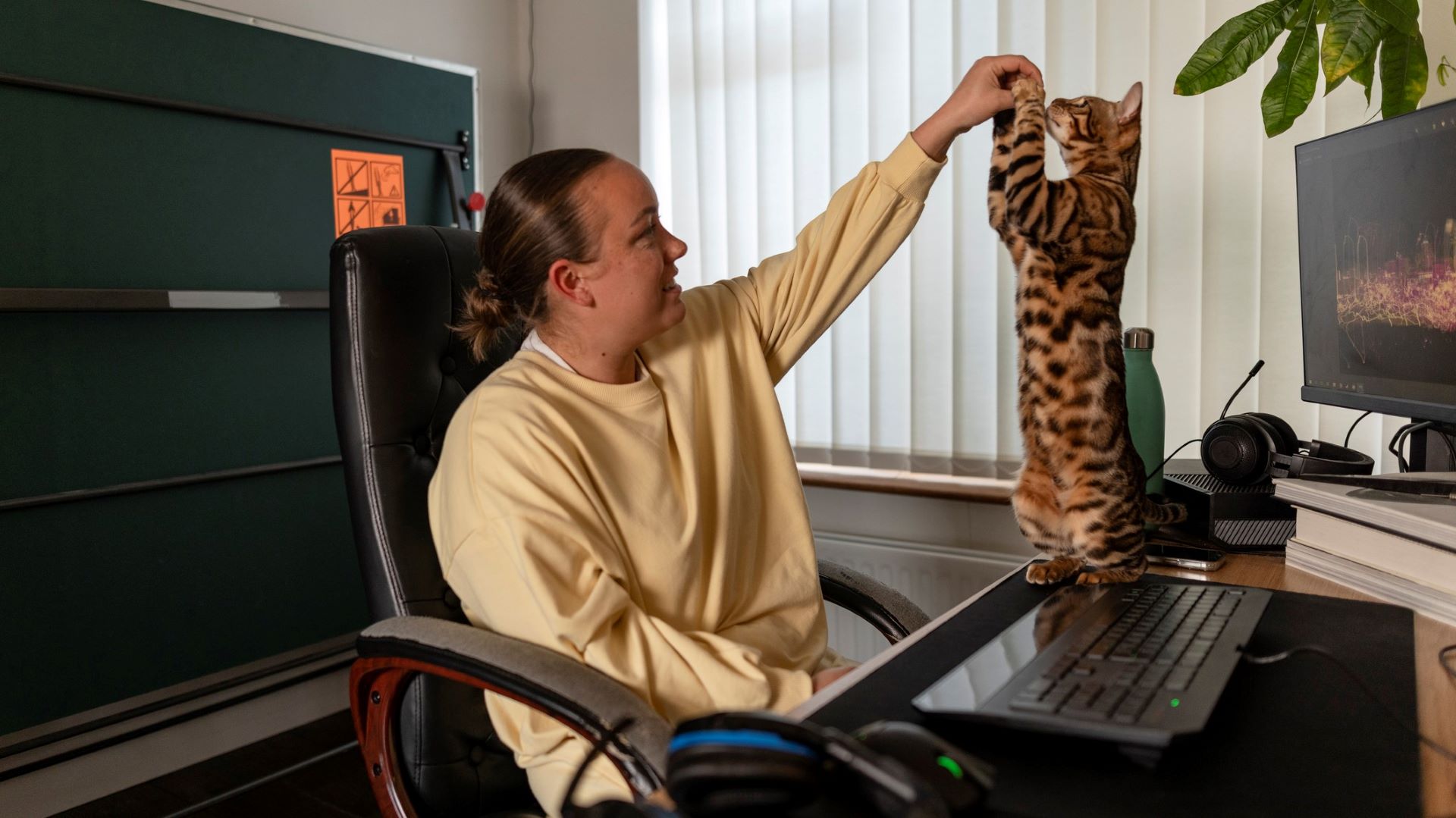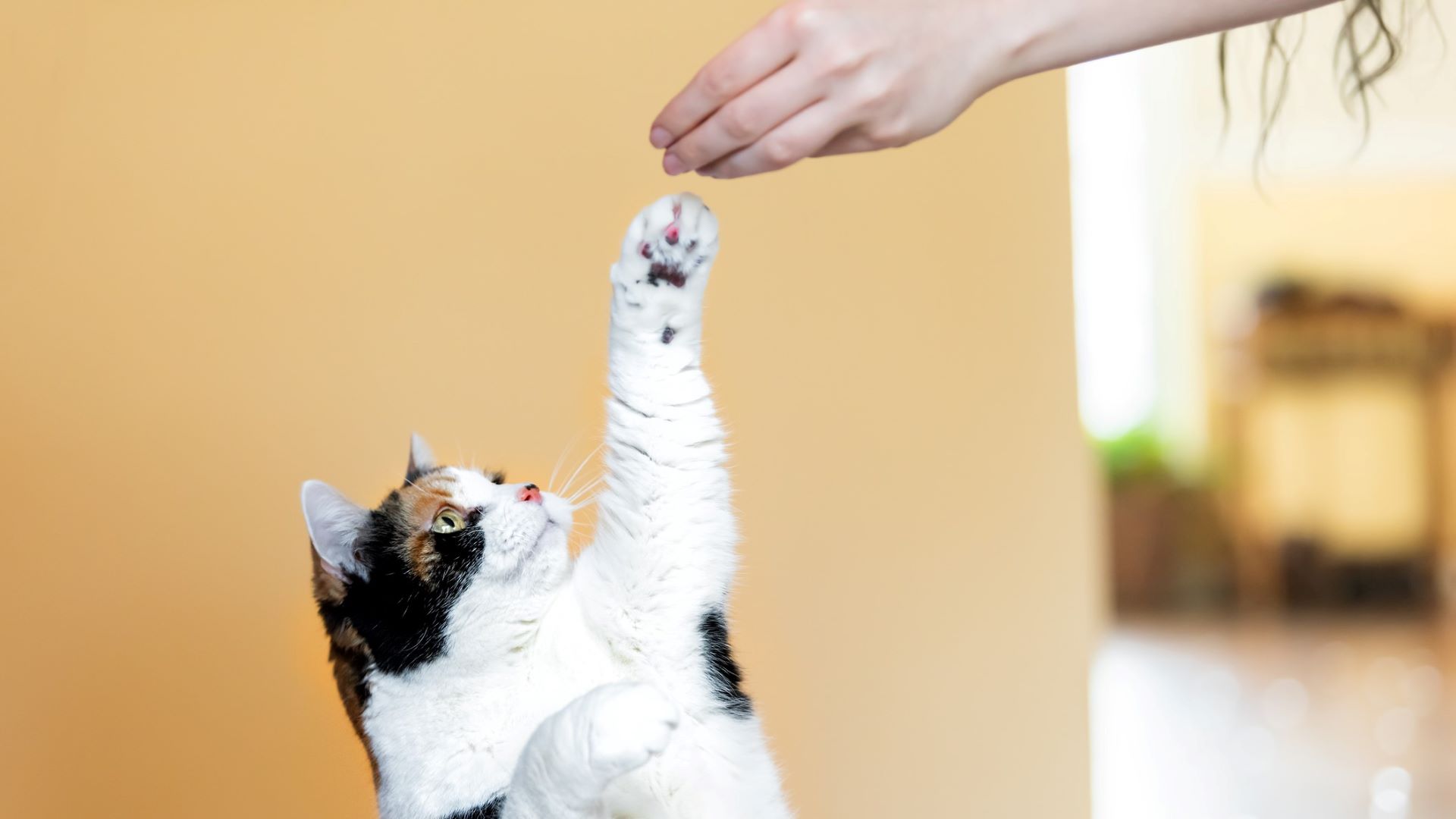Is clicker training for cats recommended?
Do you wish you had a better way to communicate with your cat and could teach them desirable behaviors? Clicker training for cats could be the answer

You may be familiar with clicker training for dogs but did you know that clicker training for cats is recommended by many feline professionals?
It’s a popular misconception that cats are untrainable. In fact, cats are constantly learning and clicker training is a fantastic way to teach them new behaviors, from fun tricks like spins, leg weaves and high-fives, that will help keep their minds and bodies active, to stress-reducing, welfare-improving activities such as voluntarily entering their carrier, cooperatively participating in nail clipping, grooming and tooth brushing, and even willingly accepting the administration of oral and topical medications.
Certified Clinical Animal Behaviourist and Animal Training Instructor Debbie Bryon says, “I absolutely love clicker training cats and I have done lots of work with my own cat, Frank. He goes wild at the sight of the clicker and the treat bag!”.
So if you're wondering why does my cat scratch the wall or furniture or how can I get them to use their litter box, stick with us as we explore the pros and cons of clicker training for cats, as well as explaining how clicker training works and the ways in which it can be adapted to suit any cat.

Debbie Bryon is a Certified Clinical Animal Behaviourist, Animal Training Instructor, and Registered Veterinary Nurse with over 20 years experience working with cats, dogs, rabbits, rodents, and a range of other species. Debbie holds a BSc in Veterinary Nursing Science, the Nurse Certificate in Animal Behaviour, and a Postgraduate Diploma in Clinical Animal Behaviour. She is an accredited member of the Fellowship of Animal Behaviour Consultants and the Association of Pet Behaviour Counsellors, and is listed on the Animal Behaviour and Training Council register.
Debbie is the founder of Positive Pet Behaviour, offering a range of behavioral consultations and training solutions. Using scientific methods and research, she supports guardians to understand why their pets are acting the way they are and what is driving their behavior.
What is clicker training for cats?
Clicker training for cats is a form of positive reinforcement training. Desirable behavior is marked with a clicker and reinforced (rewarded), making it more likely to be repeated in the future. The clicker is a small plastic device with a metal plate inside that flexes when pressed, creating a distinctive clicking sound.
At first, the sound of the clicker will mean nothing to your cat. It needs to be paired with something intrinsically rewarding, such as some of the best cat treats, so that they learn that the ‘click’ predicts that a reward is coming. This association is established by repeatedly clicking and delivering a treat to the cat, a process that is often referred to as ‘charging the clicker’. After a number of repetitions, your cat will be eagerly anticipating a treat every time they hear the click. Now you’re ready to start training a specific behavior like recall, giving a high-five, or relaxing on a mat.
What are the pros of clicker training with cats?
Clicker training is an ethical and humane method of training which builds a cat’s trust and boosts their confidence, encouraging them to try new things and offer desirable behaviors. Training based on correction, for example, spraying a cat with water if they jump on the counter while you’re preparing food, can cause fear and anxiety, and damage the cat-human relationship - water is one of the many weird things cats are scared of. Clicker training an alternative behavior, such as lying down on a mat when you go into the kitchen, prevents the undesirable behavior without resorting to punishment.
PetsRadar Newsletter
Get the best advice, tips and top tech for your beloved Pets
Clicker training is suitable for any cat, from kittens to seniors. Most cats find food motivating and are keen to work for high value cat treats but if your cat isn’t food motivated you can experiment with alternative rewards such as interactive play using a favorite toy, petting, or verbal praise. Using a clicker as a marker helps the cat precisely identify the action that has gained them reinforcement. As Bryon explains, “When you get clicker training right, the cat gets a very clear instruction of ‘yes please’ or ‘no thank you’. Using a clicker can be more effective than a vocal marker, as the ‘click’ is super consistent and never affected by your mood or a sore throat.”

What are the cons of clicker training with cats?
Clear communication is essential, to avoid confusing or frustrating your cat. If you click, you must reward your cat, even if you’ve made a mistake. According to Bryon, “Clicker training is all about precise timing and if you get the timing wrong and click too early or too late, you will be reinforcing the wrong behavior. So, you could end up accidentally asking your kitten to bite your hand instead of giving you a high-five!”. But don't worry, if you find yourself wondering, 'Why is my cat biting me?' we've got you covered with helpful insights and tips to better understand and address this behavior.
It’s a good idea to practice your clicker skills before you start training, just make sure it’s out of earshot of your cat. You could get a friend to bounce a ball and click every time it touches the floor or watch a tv show and click every time the actors blink.
Some cats are startled or frightened by the sound of a clicker. “Use a soft-toned clicker or keep it in your pocket to muffle the sound,” Byron suggests, “Alternatively, you can use your tongue or the click of a ballpoint pen. I also like to use empty sweetener containers, as their click dispenser mechanism is lovely and quiet.” Remember, the clicker isn’t a remote control, so don’t point it at your cat!
Byron cautions that, “Clicker training can be tricky to master. Initially you may feel like you need another arm to be able to juggle holding the treats and the clicker, plus extra training equipment like a target stick, all while offering training cues, clicking to mark desirable behaviors and delivering reinforcement.” Be patient - your confidence and dexterity will improve with practice.

Is clicker training recommended for cats?
Researchers have only recently begun studying the effectiveness of clicker training for cats but a study published in the Animals journal assessing clicker training for shelter cats found that clicker training enabled cats to learn to perform a variety of behaviors in a relatively short period of time and suggested that clicker training for cats has the potential to provide cats with positive enrichment, reduce stress, modify undesirable behaviors, strengthen the cat-human bond, and even improve rescue cats’ adoptability.
Clicker training gives cats a sense of control and can encourage them to become active and willing participants in their own care. Feline welfare charity International Cat Care recommends training cats for travel in a cat carrier, to accept handling for veterinary examination and the administration of medication, to prevent them from experiencing fear, anxiety or frustration and minimize the stress of car travel and visits to the veterinary clinic, cattery or groomers.

What can you use instead of clicker training?
You can still train your cat if they find the sound of a clicker aversive or are unable to hear an audible marker. According to Byron, “You can use anything as a marker. It doesn’t need to be a click. A training marker is any sound or signal the cat sees or hears immediately after successfully completing a desired behavior - a verbal “yes” or “nice”, even a thumbs up or flash of a pen torch can be used for cats with hearing impairments. This signal means, yay, you got it right, please do that again, especially when it’s followed by a reinforcer.”
Clicker training can be a fun and effective way to engage with your cat and teach them desirable behaviors, as long as you take their individual and species-specific needs into consideration. Cats have short attention spans, so keep sessions short - five minutes maximum - and always end on a positive note, reinforcing a desirable behavior with a treat and lots of praise. When we asked Byron for her top tip for beginners, she advised, “I wouldn’t just pick up a clicker and start. Get some advice and coaching first.” An increasing number of Animal Training Instructors offer cat training instruction, while places like Cat School and the Karen Pryor Academy run online classes for beginners. Once you’ve mastered the basics, you can progress to more advanced skills like feline agility or training multiple cats.
Claire Stares is a freelance writer and book author. She holds a BA (Hons) in English and a MA in Creative Writing and is currently enrolled on the MSc Clinical Animal Behavior program at the University of Edinburgh. Claire has a particular interest in feline behavior, welfare, and training, and holds an International Cat Care Certificate in Advanced Feline Behavior for Cat Professionals and a Diploma in Feline Health and Welfare. She has completed the ILLIS Animal Behaviour Courses Advanced Animal Training course and the Karen Pryor Academy Train Your Cat course.
She shares her home with five cats and volunteers for a cat welfare charity, so she's passionate about exploring how cat guardians can use positive reinforcement training and environmental enrichment to facilitate cooperative care, prevent problem behaviors, improve cats’ quality of life, and strengthen the cat-human bond.

